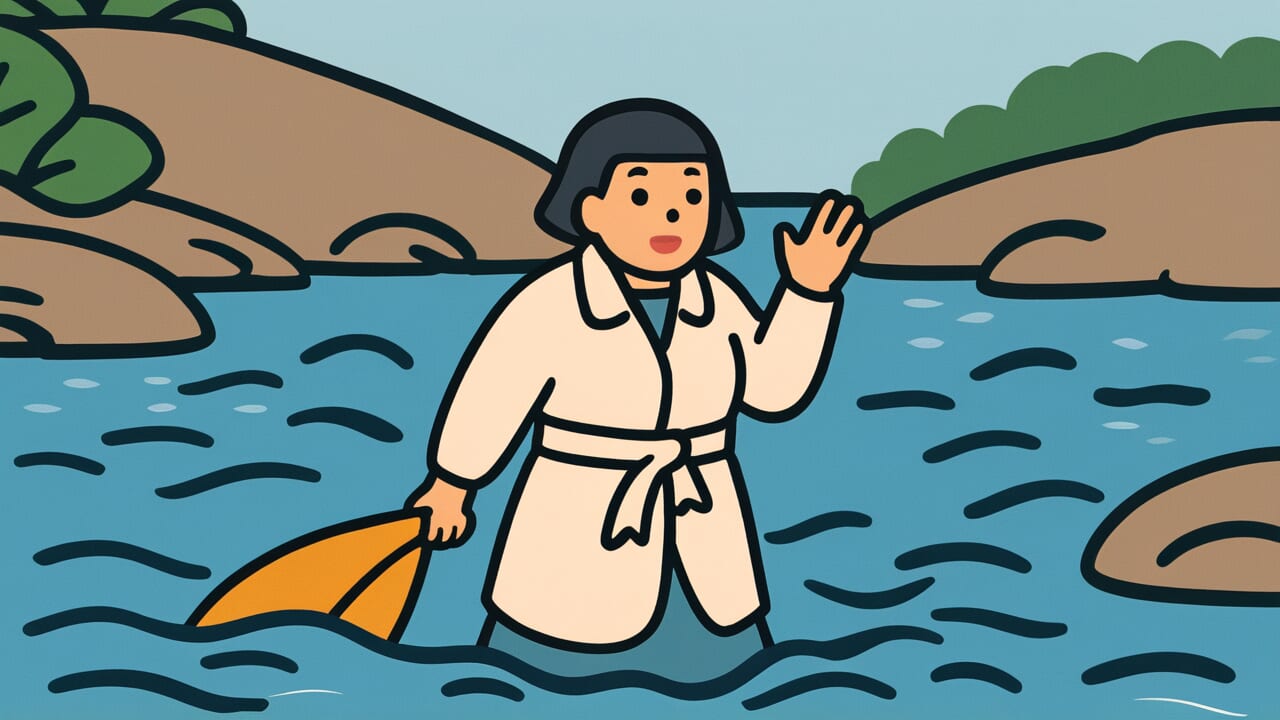How to Read “Wearing paper clothes and entering the river”
Kamiko kite kawa e hairu
Meaning of “Wearing paper clothes and entering the river”
“Wearing paper clothes and entering the river” warns against defenseless and dangerous actions. It’s like entering a river while wearing paper clothing that can’t handle water.
This proverb describes the danger of approaching situations with completely unsuitable preparation or equipment.
People use this saying when someone tries to jump into difficult situations without proper preparation. It also applies when someone takes reckless actions while ignoring obvious risks.
For example, it describes someone accepting a difficult job without knowledge or experience. It also fits someone starting a business without funds or planning.
Today, this expression teaches us “the importance of proper preparation” and “the need to respond according to the situation.”
It reminds us to prepare appropriately for any task. The clear contrast between water and paper makes this lesson easy to understand.
Origin and Etymology
No clear written records explain the origin of this proverb. However, we can make interesting observations from the words themselves.
“Kamiko” refers to clothing made from paper processed like fabric. During the Edo period, common people widely used this practical garment.
People made kamiko by layering multiple sheets of Japanese paper. They treated it with persimmon tannin for waterproofing. Still, it remained weaker against water than cloth and tore easily when wet.
This proverb likely came from people’s real-life understanding of kamiko’s properties. Entering rivers was unavoidable in daily life back then.
People crossed rivers, did laundry, and drew water regularly. Water-related tasks were part of everyday life.
In such situations, people should have worn sturdy cloth kimono. The danger and recklessness of wearing water-weak kamiko instead was commonly understood.
This proverb uses familiar everyday items to express the foolishness of acting without understanding material properties. It condenses common people’s wisdom about avoiding poor preparation and weak judgment.
Interesting Facts
Kamiko was actually an excellent cold-weather garment for common people during the Edo period. Kamiko made from many paper layers had high insulation because air pockets formed between layers.
It was considered warmer than cotton kimono. It was also light and inexpensive, making it popular among travelers and merchants. However, its only weakness was water.
Some kamiko was treated with persimmon tannin for waterproofing. Even so, it couldn’t completely prevent water damage.
Once wet, the paper fibers loosened and became easy to tear. People knew to avoid kamiko on rainy days or during water-related work.
This proverb emerged from such practical life wisdom.
Usage Examples
- Starting your own business without qualifications or experience is like wearing paper clothes and entering the river
- Attempting a full marathon without warming up is exactly like wearing paper clothes and entering the river
Universal Wisdom
The proverb “Wearing paper clothes and entering the river” speaks to universal human weaknesses: “optimism” and “lack of preparation.”
Everyone tends to underestimate challenges. Unfounded confidence like “it’ll work out somehow” or “I’ll be fine” leads people to neglect proper preparation.
This psychology remains unchanged across time. In fact, today’s information-rich world may increase the danger of mistaking superficial knowledge for real preparation.
This proverb has been passed down because the lesson about preparation’s importance applies to every era and situation.
Whether in farming, business, or relationships, good results never come without proper preparation.
Interestingly, this proverb doesn’t say “don’t fail.” Instead, it says “don’t approach things defenseless.” It doesn’t reject entering the river itself.
It simply tells you to wear appropriate equipment. In other words, challenging yourself is good, but first assess the situation and prepare properly.
This represents deep wisdom applicable to every aspect of life.
When AI Hears This
The moment kamiko touches water, the destruction of fiber bonds demonstrates a perfect example of the second law of thermodynamics: “entropy increase.”
Kamiko represents a low-entropy state where fibers are woven in orderly patterns. This means a highly organized structure. Water molecules, meanwhile, exist in a high-entropy state, moving around randomly.
When these two meet, universal law dictates that order must collapse. This process is irreversible.
Once kamiko absorbs water, no amount of drying returns it to its original state. The fiber arrangement becomes disordered, bonds break, and overall entropy increases.
This follows the same principle as breaking an egg—you can’t put it back together. In thermodynamics, this is called “the arrow of time,” a fundamental property distinguishing past from future.
What’s remarkable is how little energy this destruction requires. Normally, destroying kamiko would need great force.
But with water as a medium, collapse happens naturally and spontaneously. Water functions as a “catalyst for entropy increase.”
The foolishness this proverb depicts is actually “a choice that invites maximum destruction with minimum energy”—the worst possible decision in physics terms.
Human recklessness means deliberately giving favorable conditions to entropy, an irreversible enemy.
Lessons for Today
This proverb teaches modern people about “the danger of rushing ahead” and “the value of proper preparation.”
Modern society values speed. Quick decisions and immediate action are sometimes necessary. But that’s exactly why we need courage to pause and think.
Are you truly prepared for what you’re about to tackle? Take a calm look at each element: knowledge, skills, funds, connections, and time.
What matters is recognizing that admitting insufficient preparation isn’t shameful. Rather, honestly recognizing your weaknesses and shortcomings represents true strength.
If something is missing, supplement it before taking on the challenge. As another saying goes, “more haste, less speed.” Solid preparation is never wasted time.
To lead your challenge to success, first prepare the right “equipment.” That will protect you and become a sure step toward achieving your goals.



Comments